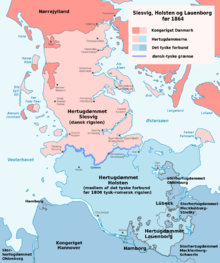General state constitution
The entire state constitution ( Danish Helstatsforfatningen or Fællesforfatningen ) of 1855 was a common constitution for the entire Danish state , which at that time consisted of the Kingdom of Denmark and the duchies of Schleswig (as a fiefdom of Denmark), Holstein and Lauenburg (the latter as members of the German Confederation) .
history
The London Protocol of 1852, which legally concluded the First Schleswig War , adhered to the state as a whole , but also stipulated that Schleswig should not be bound more closely to Denmark than Holstein. A nation-state solution favored by the German and Danish national liberals was therefore not possible. Instead, under pressure from the Allies, the paternalistic-conservative state as a whole was reintroduced.
In Denmark itself, a liberal constitution had already been passed in June 1849 , with which parliamentarism and the constitutional monarchy had been introduced. However, the constitutional connection of the three duchies remained open. The Basic Law itself offered the possibility of an extension to Schleswig, but this was prevented by the London Protocol of 1852. After the initial negotiations on a constitution encompassing the entire state had stalled, King Frederick VII introduced a first common constitution on July 26, 1854, which, however, had to be rejected by the parliament in Copenhagen and thus withdrawn again. In the same year, separate constitutions were passed for Schleswig (on February 15, 1854) and for Holstein (on June 11, 1854). After a new election in December 1854, new negotiations were finally started, which led to the adoption of the entire state constitution on October 2, 1855.
The bilingual state constitution created constitutional brackets between Denmark and the three duchies in that overarching policy areas such as foreign and financial policy were dealt with by a joint Imperial Council . The Basic Law of 1849 thus retained its validity for domestic political areas in Denmark, but was supplemented at the level of the general state by the general state constitution. The individual territories of the entire state functioned like partial states to one another. The constitutional construction of the overall state constitution, however, also meant that Denmark continued to be run as a constitutional monarchy with the Basic Law introduced in 1849, while the duchies continued to be governed absolutistically with advisory assemblies of estates elected according to a census suffrage .
The entire state constitution was a compromise under the provisions of the London Protocol of 1852, which was not undisputed. On the one hand, the Reichsrat was composed according to § 22 of the general state constitution according to a privileged right to vote and thus represented a restriction of general democratic rights in relation to the Danish Basic Law. On the other hand, the assemblies of the duchies were not involved in the negotiations. Accordingly, the constitution was rejected by the Holstein Assembly of Estates , which was dominated by the German upper class, and also by the German Confederation in 1858 . The constitution was therefore only valid in Denmark and Schleswig from November 1858, which was not tenable in the long term. Under the influence of the Danish National Liberals, the entire state constitution was finally replaced in November 1863 by the November constitution , which only applies to Denmark and Schleswig .
